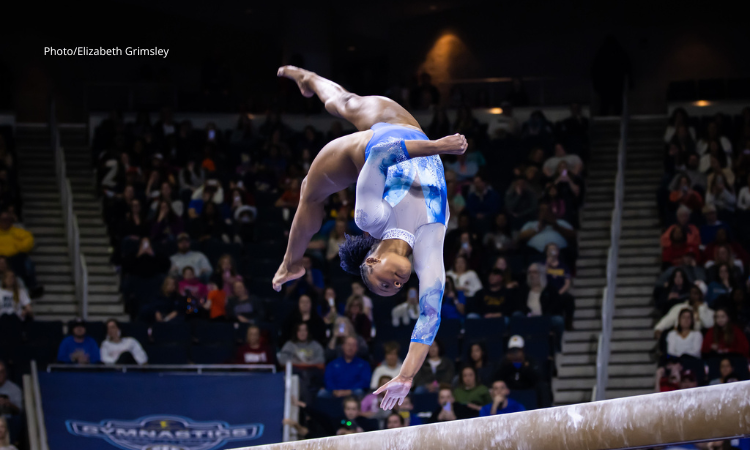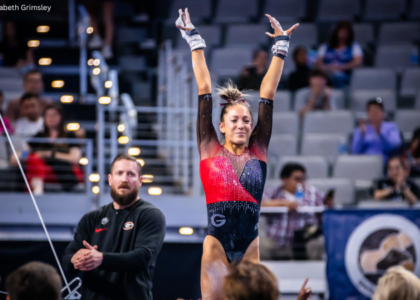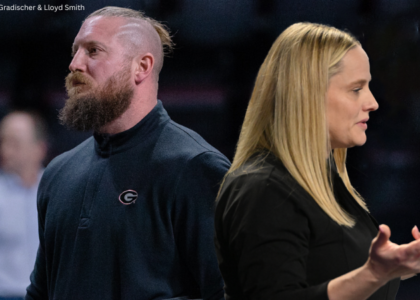Determining the Greatest of All-Time, or GOAT, has become an increasingly common debate among sports fans. While some sports lend themselves more easily to this exercise, gymnastics, which relies on some level of subjectivity within its scoring, proves a bit more vexing. Looking at NCAA gymnastics specifically, which doesn’t differentiate between difficulty and execution scores like in the elite system, it is even more difficult to compare the caliber of skills and form of different athletes. So the question arises: what criteria can we use to crown a GOAT in NCAA gymnastics? Is it an athlete’s impact on their team? Their postseason success? Or could it be the number of awards they earned over their career, their amount of perfect routines, or maybe their high scores on each event? What does it truly mean to be the best of all time? This Data Deep Dive examines NCAA success from a multitude of angles to truly define what makes a gymnast the greatest at their craft.
In order to compile an initial list of potential GOATs, we looked at gymnasts who met any of the following criteria:
- NCAA All-Around title winner
- NCAA Individual title winner on 2 or more events
- AAI Winner
- Gym Slam (an athlete who scored a perfect 10 on each of the four apparatuses)
- All athletes who scored more than eight perfect 10s
We then took the athletes who met that criteria and statistically compared them in order to determine which achievements within a gymnast’s career give them the honor of being named the GOAT of NCAA gymnastics.
We started off with the most obvious measure: the number of 10s scored over an athlete’s collegiate career. As the following chart demonstrates, gymnasts who scored a lower number of 10s had a mixed range of all-around high scores, whereas the gymnasts with the most perfect 10s have higher all-around scores.
When we performed a statistical analysis gauging how significant the number of 10s was on all-around performance, it was found to have the most significant impact out of every variable we examined.
Verdict: GOAT Determining
Next, this analysis looked at how AAI winners perform relative to other top performers in the sport.
Despite the minimal debate surrounding recent AAI nominees, AAI winners mathematically perform worse in the all-around compared to nonwinners. Additionally, AAI winners seem to deviate in peak performance scores compared to those who didn’t win the award. When looking at all-around means in general, AAI award winners and nonwinners perform similarly. Looking at the area of the pink boxes, we can see that the mean for AAI winners falls within the middle 75% of scores awarded to nonwinners.
Verdict: Not GOAT Determining
Next, we move onto the coveted Gym Slam. The 13 gymnasts in this elite group have scored a perfect 10.0 on each apparatus, thereby proving dominance across all four events and signaling unprecedented performance within the sport.
As with the number of 10s, the achievement of earning a Gym Slam was proven to be statistically significant in regards to all-around performance. To bolster its significance in success in NCAA gymnastics, the overall performance of athletes who achieve a Gym Slam greatly outpaces that of athletes who do not. The average high score for what we will call a ‘Gym Slammer’ is well above the 75th percentile high score for non-Gym Slammers. Strikingly, a 25th percentile all-around score for a Gym Slammer almost beats out a 75th percentile all-around score for someone who has not achieved one.
Verdict: GOAT determining
In the realm of postseason success, titles have proven tricky in proving overall success. Even Trinity Thomas, whose name is always included on a list of the best-of-the-best, only garnered post season titles in one out of her five seasons! This is likely due to the fact that a title win comes down to an athlete’s performance on one specific day, as opposed to the consistent success the greatest gymnasts of the sport enjoy.
Very few of the gymnasts filtered out to meet the criteria of this analysis ever won event titles at nationals, with no significant analysis that can be derived past two event titles. Even when we compare the event title numbers using enough gymnasts to make the pool significant, those who have won event titles perform worse in the all-around than gymnasts who haven’t won titles.
This conclusion reigns true for winners of the all-around title as well. National all-around title winners perform significantly worse than athletes who haven’t won the all-around title, with about a tenth difference between the means. Over time, so many NCAA greats have missed out on the coveted award due to injury, postseason mishaps or even just bad luck, and it shows within this analysis.
Verdict: Not GOAT Determining
When all is said and done, the achievement of a Gym Slam and the number of 10s a gymnast has earned have the most significant impacts on the greatness of a gymnast’s all-around performance. The following gymnasts have earned the Gym Slam and have tallied over eight perfect 10s, making them the greatest of all time within this analysis:
- Trinity Thomas – Florida
- Maggie Nichols – Oklahoma
- Kyla Ross – UCLA
- Kristen Kenoyer – Utah
- Jade Carey – Oregon State
- Alex McMurtry – Florida
- Ashley Kelly – Arizona State
- Bridget Sloan – Florida
- Courtney Kupets – Georgia
Since it’s so difficult to determine a GOAT in NCAA gymnastics given the subjectivity of the judging, we sought to define what sets a gymnast apart as the best in their craft by analyzing various quantifiable factors such as impact on their team, postseason success, awards, perfect routines, and high scores on each event. Taking these factors into account, the conclusion drawn from this analysis is that the achievement of a Gym Slam, as well as the number of perfect 10s earned by a gymnast, have the most significant impact on their all-around performance. There are other important factors that are too difficult to quantify, such as leadership and longevity, that likely contribute to a gymnast’s legacy. Given the approach we took here, we were unable to include those factors in our analysis. Nonetheless, we believe that the findings presented here provide valuable insights into what defines the greatest gymnasts in the realm of NCAA gymnastics. Given what you’ve just read, who’s your pick?
READ THIS NEXT: Data Deep Dive: What Makes an MVP in Gymnastics
Like what you see? Consider donating to support our efforts throughout the year!





Do you feel the athletes taking their fifth year of eligibility due to COVID have an unfair advantage over athletes having the normal four years? Also, how can you account for the missed opportunities of 2020 graduates (specifically Kyla Ross and Maggie Nichols) due to the COVID-shortened season?